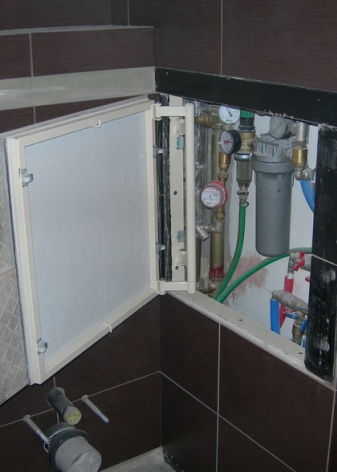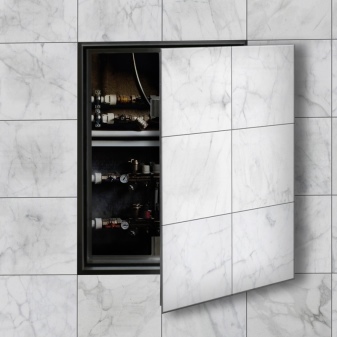Features and sizes of sanitary hatches for bathroom and toilet

A plumbing hatch is a door that covers an opening on a wall surface in a bathroom or toilet. The hole contains all the plumbing fixtures that are usually hidden behind the finish - a pipe, a heating device and water meters. In other words, the devices are outwardly unattractive, but they require constant and quick access.


Criterias of choice
The decoration of any interior of a bathroom or lavatory was originally designed to mask the entire water supply system. This gives the room a cleaner and more functional look. The plumbing hatch is one of the elements that do an excellent job with this task.


There are a number of criteria to focus on when buying:
- product resistance to moisture;
- the material used in the manufacture;


- durability;
- impact resistance and wear resistance;


- the possibility of subsequent finishing of the product;
- dimensions;
- opening method.


In addition to this, it is a prudent step to find out if the purchased hatch lends itself to staining and puttying. Decide in advance whether it is important for you to disguise the hatch under a decorative coating or leave it in its original form.
Views
A plumbing hatch can be classified according to various characteristics. For example, on the site of installation - in the bathroom or toilet. The hatch can be installed in the floor, if there is a floor heating system. But most often, a ceiling surface or wall is used for the installation of a plumbing hatch.


The difference also lies in the locks, in the methods of opening the hatch and the materials used in the manufacture of the product. Consider the types of sanitary hatches most often used in residential premises.


- Push
A push system is used to create it. Opening takes place with light pressure on the outer part of the product. Doors can be presented in different versions: hinged, sliding, opening in one or two directions. Due to the use of a push system, this model is not equipped with a handle or a suction cup.


The door can be faced with any building materials, even with relief tiles.
The push-down model has a number of advantages in contrast to its counterparts:
- ease of use;
- strength;
- quick and easy installation;
- the possibility of any decor.


It is worth mentioning that this model opens in two steps. The first - when pressed, the model moves to the side, the second - in the open state, the door can be pushed to the side. The push model is applicable both in the bathroom and in the restroom. Most often it is mounted next to the toilet, which makes it invisible to the eyes.


- Swing
Due to the simplicity of the design, this option has become the most demanded of all the plumbing hatches presented. The device is extremely simple. The door is connected to the frame by means of two hinges.
Spontaneous opening of the doors is excluded thanks to the wedge-roller latch. Provided that it is tiled with ceramic tiles, the product in the open state is in line with the base. Suction cups or handles are fixed on the sash.


The positive characteristics of this model include ease of use and installation, the ability to position the product on the wall and floor surface, and a reasonable price.This model assumes independent installation without the invitation of specialists.


- Folding
This product is applicable for hard-to-reach places where it can be difficult to open or move the doors. Pressing down allows the door to open at a forty-five degree angle. The door, in turn, is secured with a chain and a carabiner. This model is suitable for monitoring communication systems and tracking data from water meters. If you need full access to the communications system, the plumbing hatch can be removed entirely.


The main positive characteristic of this model is the possibility of installation in inaccessible areas. The same fact is a significant flaw of this variety. The fact is that after each full opening of the hatch, you will need to adjust its position.


- Sliding
This model is applicable in small-sized premises, where the possibility of placing swing doors is excluded. This model is equipped with a magnetic clamping system. In order to open the sanitary sliding hatch, the model is equipped with specialized suction cups or a push device.


Plumbing hatches, which are based on a magnetic system, have a number of advantages: in order to access the communication system, a large space around the hatch is not required, due to the low weight of the hinge doors, they receive a minimum load.


Among the shortcomings, one can note the difficult installation, the inability to install on the floor surface and the high price. This model lends itself well to facing. It can be located under the bathroom, behind the toilet and in the installation.


- Roller shutters
Along with the swing model, they have become widely used in residential premises. Most often, this option can be found in the bathroom above the toilet. It is a complexly designed structure that winds on specially provided shafts. The product is extremely comfortable to use and does an excellent job of masking the communication system.


Manufacturers of this model offer a wide range of roller shutters made of different materials: plastic, aluminum, wood and perforated sheet. It is easy to assume that it is the plastic model that is most in demand among consumers. Such a product has a reasonable cost, moisture resistance, and attractive appearance.


Of the positive qualities of this model, one can single out:
- a wide variety of different colors;
- full accessibility to the communications system;
- the strength of the device;


- long service life;
- high resistance to moisture;
- the possibility of location in any place convenient for you;
- lends itself well to coloring and finishing.


The disadvantages of the plastic model are the rapid accumulation of dust and the likelihood of purchasing a low-quality product.


The size
Most sanitary toilet hatches are rectangular or square in shape. Manufacturers offer standard sizes, regardless of the materials used in the manufacture and the specificity of the design.


For a city apartment or private house, there is a certain range of sanitary hatch sizes:
- width - from fifteen to sixty centimeters;
- height - from fifteen to eighty centimeters;
- depth - from thirty to thirty-five millimeters.


Taking into account that the standard dimensions of the product do not always turn out to be suitable for the buyer and correspond to his needs, many companies provide a custom-made service according to the required dimensions. For example, for the finishing of large-sized communication units, where more than two specialists are required for repair and preventive maintenance. Manufacturing of an individual plumbing hatch does not take more than six days.It should be noted that the price of this product will differ significantly from the price of a standard size model.
Mounting
Consider an approximate algorithm for installing the hatch. Installation does not require special skills and knowledge, and you may well be able to handle it yourself.
- The preparatory stage is the construction of a plumbing cabinet directly. It must be located next to water meters or a heating device.


- The plumbing cabinet can be made with your own hands. Such a technical revision element basically has a size of 60x120 cm. The cabinet must be hidden, so it is advisable to place it in the corner of the room or close it with some object. It is necessary to mount a frame in the cabinet for fixing the plumbing hatch.


- If you want to install an invisible hatch, then finishing work in the room is recommended to be carried out simultaneously with the installation of a plumbing hatch. In the case of using ceramic tiles for finishing, it is necessary to take into account the proportions of the hatch doors and cladding. For a more tight connection with the tiles, pre-prime the surface of the hatch door.


For information on how to install a plumbing hatch, see the next video.













The comment was sent successfully.